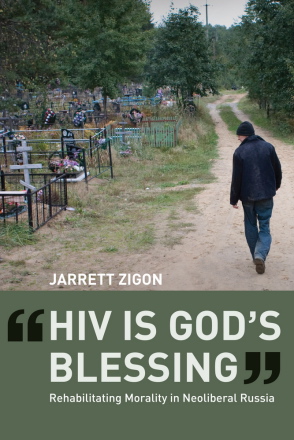
The new book, HIV is God’s Blessing, provides an anthropological examination of a Russian Orthodox program treating drug addicts and HIV sufferers as they blend Orthodox spirituality with self-help therapy. Author Jarrett Zigon of the University of Amsterdam studied a church-run treatment center in St. Petersburg and found that its approach clashes with the Russian Orthodox Church’s human rights position which is critical of Western society.
HIV infections show the fastest growth rate in the world in Eastern Europe and Central Asia, with Russia registering the highest number, reaching up to one million persons and spread mainly through intravenous drug use. Most of the funding to fight the disease and help those afficted with the disease has come from outside funding agencies. Even Orthodox programs targeting HIV and drug addicts receive most of their funding from outside groups and get little support from the official church, according to Zigon.
Although the Russian Orthodox Church has sponsored various prevention programs aimed at youth as well as holding counseling and educational seminars, it was not until 2004 that the church made an official statement on HIV, releasing it to the media a year later. The document, entitled, The Concept of the Russian Orthodox Church’s Participation in Overcoming the Spread of HIV/AIDS and Work with People Living with HIV/AIDS, committed the church to fighting the epidemic, viewing it as detrimental to the moral life of the nation. The statement also chastised Western churches and other relief organizations for their “pragmatism” and “harm reduction” approach that tolerates the behaviors that have spead AIDS, such as drug use homosexuality.
The most concerted Orthodox effort to rehabilitate and treat heroin users, who are often infected with HIV, is the center on the outskirts of St. Petersburg run by clergy, psychologists and laity, many of whom are former addicts. The compound is known as “the Mill,”a three month residential program where church approved self-help techniques are added to such strategies as talk, art, and film therapy and Orthodox teachings and practices, such as prayer and confession. While full conversion to Orthodoxy is the goal of the program, there is also the realization that the majority of clients will not convert and therefore hold out for the secondary goal of their living a normal, drug-free life.
Zigon writes that the key concept emphasized at The Mill is the need to “work on oneself.” This idea has its basis in both Orthodoxy and in the nation’s Soviet history and relates to the belief that one can remake oneself into a new moral person. Orthodoxy teaches that through personal discipline and spiritual assistance from the church, one can achieve a state of holiness and spiritual perfection. In a somewhat similar way, Soviet communism asked each individual to “internalize societal interests as his or her own” and contribute to the realization of a communist nation. A strong element at The Mill is the need for discipline and surveillance of clients to make sure they don’t lapse back into their addiction.
The concern about clients reverting back to their heroin habit when they leave The Mill has led to a practice of monasteries and parishes taking some in to extend their period of rehabilitation. Most go back to the city and try to avoid their own networks and social circles where drug use is encouraged. In this case, the program runs meeting where former clients can discuss issues in their lives and encourages friendship support networks so ex-addicts can help each other withstand temptation to use again. But Zigon notes that The Mill reports a success rate of 25 percent (meaning that only this percentage does not return to eventual drug use).
Those who go to parishes or monasteries after their stay at The Mill are more likely to stay clean from heroin, but even those who eventually return to their drug habit value the program for allowing them to live a normal life for a short period of time. The Orthodox practice of prayer, especially praying the short “Jesus Prayer,” helps the former drug users avoid temptations to take up their drug habit. Confession and “public penance” in the form of discipline and punishments when an individual breaks rules at The Mill tries to instill self-discipline and a new moral identity to reenter society.
Zigon concludes that a program such as The Mill is suited to the “new Russia” which is based on self-help, personal responsibility and decentralization. Such values may appear to conflict with the human rights statements of the Russian Orthodox Church, which criticizes Western capitalism and individualism. But he writes that the church-run program for drug addiction and HIV finds itself producing “responsibilized subjects who are now better disciplined to participate in the very Western-oriented neoliberal world from which the church had hoped to save them.”
Richard Cimino
Jarrett Zigon , HIV is God’s Blessing: Rehabilitating Morality in Neoliberal Russia, University of California Press, 2010, 280 .